Frankenstein: the True Story Part Two – 1973
“His limbs were in proportion, and I had selected his features as beautiful.” — Mary Shelley, Frankenstein
“You loved your Creature so long as it was pretty, but when it lost its looks, huh? That was another matter.” – Dr Polidori, Frankenstein: the True Story
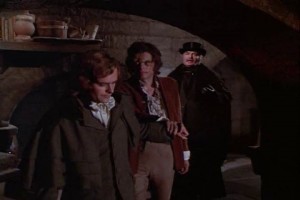
After the events of Part One, the Creature (Michael Sarrazin) has survived his plunge into the English Channel. Dragging himself ashore, he hides out in the home of a blind man (Ralph Richardson). He befriends to the man, and falls in love with his daughter (Jane Seymour). Alas, he scares her out of the house and she is fatally run over by a coach.
The Creature takes her body to the house where he was made, only to find that Victor is not there. The building has been taken over by Dr Polidori (James Mason). Polidori was introduced in the first episode as a former colleague of Clerval’s whose research took a different direction because Polidori was frightened of electricity.
(The name Polidori comes from Dr John Polidori, Lord Byron’s personal physician. In 1817, Byron, Polidori, and Percy and Mary Shelley decided to have a competition to see who could write the best horror story. Mary Shelley wrote Frankenstein, and Polidori wrote The Vampyre, a book that a) represented the birth of the vampire story as a literary subgenre, b) is a none-too-subtle attack on Byron, and c) is not very good.)
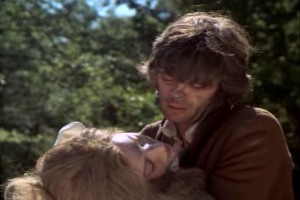
Polidori is planing to create a female monster. By using the head of Agatha as the head of his creation, he realises he can manipulate the Creature into helping him. He hypnotises the Creature, and is astonished to find Henry Clerval’s mind somewhere inside a psyche comprised of a mixture of the people the Creature is made of.
Meanwhile, Victor Frankenstein (Leonard Whiting) prepares for his wedding to Elizabeth (Nicola Paget). With the help of the Creature, Polidori blackmails Victor into helping him create a female monster, forcing Victor to abandon his bride on his wedding night. Polidori cannot make the creation alone, since his hands are crippled. Victor complies, stitching Agatha’s head onto a new body. This new monster, Prima (Jane Seymour), is brought to life by means of a flaming chemical bath. So the male monster is basically beamed down from the sun, while the female monster arises from the depths. Now that’s symbolism for you.

Victor dashes off on his honeymoon, but returns to find Prima is staying at his parents-in-law’s house. Polidori, her ‘guardian’ is hoping she’ll be introduced into Society. Prima is beautiful but cruel and mischievous. She attempts to seduce Victor, and also tries to strangle a cat. She also refuses to ever remove a neck band that she wears, and flips out at the sight of sewing. Elizabeth sneaks into Prima’s room and sees her sleeping without her neckband, her neck scar visible. Victor silences her before she can freak.
Victor races off to confront Polidori, who claims that he intends to leave. In a gesture of goodwill, he promises to destroy the Creature in a vat of acid. Victor’s resolve weakens, but he helps Polidori talk the Creature towards the acid tank. At the last moment, he warns his old friend, who runs amok. Polidori traps the Creature in the cellar and sets fire to the house, cursing Henry Clerval and denouncing Frankenstein as a hypocrite while he does so.
Next up is the huge ball where Prima is to make her debut into Society. Victor drinks sullenly, while Prima dances and Polidori boasts. Polidori plans to use Prima’s beauty to leverage himself into power. He means to use her beauty to manipulate important figures, and in this way control Europe invisibly. It’s good supervillain stuff, but his glee at the thought of seducing powerful men (albeit by proxy) suggests a different motivation.
At the height of the ball, the Creature bursts down the doors. He crosses the ballroom towards Prima, past shocked and stunned gentlemen, then removes her collar revealing her scar. Then, he tears her head off.

“Why?” Victor asks.
“Beautiful, Victor,” the Creature. “Beautiful.”
I remember asking my Grandmother what this meant, and she said that the Creature didn’t want Prima to decay and become ugly like him. That’s a reasonable theory. Another possibility is that he recognises that the monstrous creature before him isn’t his beautiful Agatha. Perhaps he’s not saying “beautiful, Victor” but “beautiful Victor”, ie I did it for you. It’s a wonderfully ambiguous piece of writing with so many satisfying interpretations.
Elizabeth manages to outwit the local constable (John Gielgud) and she and Victor leave for America. Elizabeth tells Victor she is pregnant, and they hope to make a new life together. Alas, Polidori has booked passage on the same ship. As Victor is driven further into drunken depression by Polidori’s demands, Elizabeth searches Polidori’s cabin and discovers the Creature has stowed away on the ship. She tricks Polidori into the cabin, then locks the doors. Telling Victor what she has done, Victor releases Polidori and the Creature, and Polidori flees to the deck to seek help from the crew. There is a storm, Polidori is terrified by the lightning. The Creature fights off the crew and drags the pleading Polidori up the mast and ties him there, until he is struck by lightning.
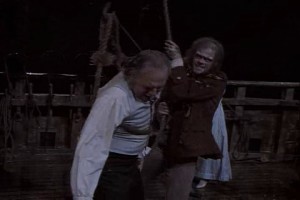
Victor is knocked out in the conflict. The Creature puts him to bed, tending his injuries in a surprisingly professional way. The crew has been rallied by their captain (Tom Baker) and attempt to kill the Creature, but he fights them off and they abandon ship. Elizabeth stays and confronts the Creature, comparing his unnatural life to the life of her unborn child. The Creature addresses her in Henry Clerval’s voice, then strangles her. He pilots the ship north into the Arctic.
Waking, Victor discovers the ship deserted and icebound. He staggers across the fields of ice to the dim, distant shape of his creature, standing by a lonely mountain. First he berates the Creature for its evil, then breaks down and apologises for creating him, and then attempting to destroy him. Victor says that he wants to die, and will soon freeze to death. He accepts that leaving the Creature all alone, living forever is intolerably cruel. After three hours of reacting to events, he finally takes responsibility for what he has done and begs the Creature to forgive him. The Creature doesn’t.
So Victor asks louder and starts an avalanche. Creator and Creature are reconciled, as they are both buried alive beneath the ice.
It’s weirdly touching. They’ve both done great wrong, and by the rules of fiction they deserve to die. One killed a bunch of people, the other irresponsibly created the conditions that lead to their deaths. They’re both doomed monsters — but there’s no reason they should die angry at each other. Victor and his Creature have been through a lot together. Why shouldn’t they die friends?
The gay subtext of the first part is pretty clearly still present. This is the part where Victor and the Creature attempt to form heterosexual relationships which go terrifyingly wrong, and so end up back together.
The flip side of the movie’s positive gay theme is that it is really kind of sexist. Granted, none of the male characters come across as unambiguously good, the female characters come off even worse. Victor’s landlord is silly and ignorant, as is the minor character of a comical aging countess. Elizabeth is shown to be driven by prejudice and though most of her actions are perfectly understandable, she still comes off as unsympathetic. Her death at the hands of the Creature is particularly undeserved.
Part of the problem with Elizabeth is that I think she was written as a symbol first and a character second. She represents what Victor is supposed to want in life–fatherhood, religion and social status. Victor wants those things, sure, but more than that he wants to throw that all away and do secretive things with other men in dark places. As a symbol, she has to die in order to allow him to accept that part of his life. However, as a person she is very badly done by. She’s shown as intelligent, loyal and determined, and her death is probably the hardest to take.

Prima is shown a bundle of misogynist stereotypes of women – a deceptive, attention seeking sexpot. While the Creature is initially kind and only becomes violent and cruel after being mistreated, we never see the good side of Prima. On the other hand, we also don’t see her upbringing at the hand of Dr Polidori. It’s not clear how much of her behavior is her own untrammeled id, and how much is it Polidori’s attitudes made flesh.
Having said all that, at least Frankenstein: the True Story actually has a couple of meaty roles for female actors. Quite a lot of Frankenstein movies don’t.
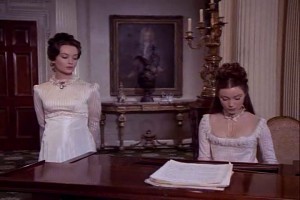
I wrote a bit last week about the character of Victor, but didn’t say much about the Creature. Last week there wasn’t much to say. The Creature was a happy, kindly thing who loved Victor and the opera. The ending of that episode – his own despair and Victor’s implicit rejection—set him on a different course. Rejected by the old man and his family and guilt ridden for killing Agatha, he talks to Polidori and holy crap! His mind is composed of elements of the people he’s built from. “I am Legion,” he says, “for we are many.”
(If this is true of Prima too, then perhaps Polidori sewed poor Agatha’s head onto someone really nasty. That would certainly explain why the Creature was so keen to sever the connection.)
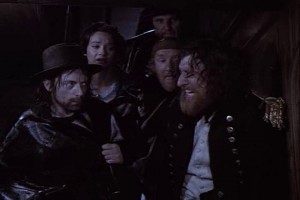
What’s more, Clerval’s entire psyche is in there somewhere, presumably since he is the brain donor. This comes out a couple of times – when the Creature speaks in Clerval’s voice, when he tends the injured Victor and sometimes simply when he stands in a Clerval-like manner. He calls Polidori “Polly-Dolly”, which was Clerval’s nickname for the man. He share’s Clerval’s vanity – Clerval was constantly checking himself out in mirrors, and it was by looking in a mirror that the Creature realised that it was becoming ugly.
And yet, the Creature himself is not Clerval. He usually lacks Clerval’s vocabulary, communicating in the same handful of words that he learned in part one. He falls for tricks that clearly wouldn’t have fooled a trained scientist. It’s one of those things that I love in speculative fiction, where the exact mechanism is clearly well thought out but never quite explained, leaving the viewer trying to figure it out — never quite certain of success. The Creature’s rising cruelty with each successive rejection and betrayal is easier to comprehend.
Frankenstein: the True Story is one of my all-time favorite Frankenstein films. It works on so many levels – as horror film, as a psychological portrayal of a particular form of relationship, as a period piece… It’s a deeply complex story, and every time I watch it I notice something I hadn’t seen before. I almost hated to review it. I’m pretty sure I did justice to Santo vs Frankenstein’s Daughter, but I doubt very much that I did justice by this True Story. It’s massively deep, and I could have written a whole article just on the way it adopted and adapted ideas from previous Frankenstein movies and made them its own, or trying to work out some of the more esoteric symbolism.
But I’m not Victor Frankenstein. I know my limitations, and for better or worse, I don’t try to go beyond them.
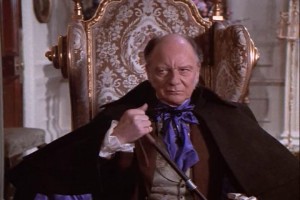





I really enjoyed reading this review. Thank you! Have you read the Little Shoppe of Horrors special edition (#38) dedicated exclusively to the movie?
Haven’t, and wasn’t aware of thay magazine until now. Thanks, I’ll check it out.